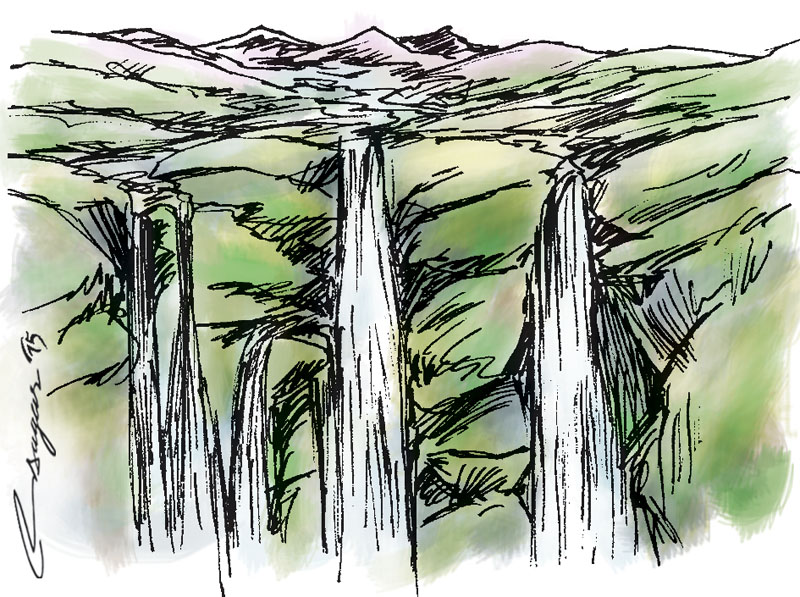Our biggest natural resource
Nepal can generate the cheapest electricity in the world. Even the least cost coal based electricity generation (say in India) can’t compete with Nepal and that is mainly due to the costs associated with excavation, transportation and storage of coal (forget the environmental cost)
Nepal’s efforts so far over three decades in the energy sector have yielded a mere 2.2% hydro-power share and 0.8% renewable share in total energy mix. Even the contribution from animals of Nepal is much bigger in this regard - animal dung with almost 5.5% share (WECS 2010, MoF 2013). This shows the competency level of energy sector leaders who so far have been working in Nepal, and this also includes foreign giants serving Nepal through WB, IMF, ADB and various other international development agencies. Most of them seem to have a misconception about Nepal’s water. Unfortunately, water is not the main resource of Nepal, the biggest natural resource of Nepal is its unique steep gradient geographical feature. These features, if understood properly, provide Nepal an opportunity to have many cheap high altitude natural dams for enormous water storage. The presence of eight among top ten peaks of the world have given Nepal a unique geographical composition where substantial water mass is available at high altitude - both regular and seasonal (rain) water.
Nepal needs to explore a perfect hydro model that yields most out of each and every drop of water, and the present business as usual approach is nowhere close to it. Many of the world’s giant high head pumped storage hydro-power projects are possible in Nepal, but this needs an out of box approach. This requires a new vision to look at Nepali water in bulk at different elevations and not individually in different segments of a river. This approach requires a few stable north-south corridors where reliable high head water-ways channels in bulk can be constructed for the world’s most efficient water-energy conversion.
The latest threat of global warming and climate change issues in Hindu Kush region are making water a scarce item. Drought and water scarcity in India is known to all. Under these circumstances, wise and sustainable use of Nepali water requires advocacy for water as a raw material for the hydro-power Industry. To initiate it, Nepal needs to change its MW based royalty with royalty for water use on “per liter basis”.
Nepal can generate the cheapest electricity in the world. Even the least cost coal based electricity generation (say in India) can’t compete with Nepal and that is mainly due to the costs associated with excavation, transportation and storage of coal (forget the environmental cost). With this cheap electricity, Nepal can afford to produce cheaper alternative fuel carrier (hydrogen fuel) like Iceland did – a model so far ignored for many reasons. But in our case, air pollution due to massive industrial activities in India and China has provided us an ideal venue for our new product launch (i.e. hydrogen fuel). However, Nepal should prefer trading of hydrogen instead of electricity and the reason is obvious, trading potato chips is far more beneficial than trading potatoes.
Unlike Iceland due to its islandic nature, diffusion of Nepal’s cheap hydrogen fuel is possible through CNG fueled vehicles in the beginning. The Indo-Nepal open border will be an asset for this diffusion and CNG vehicles will help avoid the tussle against the vehicle manufacturers to some extent. Thus, with hydrogen fuel as the final hydro-resource product (after electricity use in Nepal), Nepal does not need cross-border transmission lines for electricity trade.
A bulk water mass realization at different elevations and especially in the higher altitude of Nepal provides favorable ecology to the Himalayan region and retards ice melting and water drain-out process. This will finally lead Nepal to have three gradient lakes system from east to west. Presence of many pumped storage projects will eventually make “Nepal the biggest natural battery system of the world”, where renewables like solar and wind of entire region (if needed) can be used to pump water back to higher elevation dams. These three gradient lakes system not only avail the means for rain water harvesting, but will also help in flood control significantly. This also provides opportunity to maximize the use of every drop of water. With bulk water mass realization at different elevations, Nepal can easily regulate the flow of water towards the needy corridors of India to fight against drought and thirst (water security). This controlled water can also be used in navigation.
Moreover, based on Icelandic experience hydrogen fuel is the best means of energy storage which not only be used for transportation, but can be used to generate electricity as and when needed.
Hydrogen fuel can help Nepal to be a hundred per cent fossil fuel independent country. With proper design and exploitation of its water and geographical features, Nepal can produce enough hydrogen fuel for the entire South Asian region - a true gift from Nepal to fight air pollution in the region. Nepal also can earn a huge amount of money from carbon trading (avoided fossil fuels in the region).
This unique resource can be used and exploited for the better global cause - mitigating air pollution in the region and contributing to the world climate. And this is only possible if Nepal starts a fair contest in its hydro-power sector – maximum energy and maximum revenue per liter of water use. This is the only way for a quicker prosperity of Nepal.






